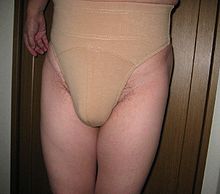- Dance belt
-
For other belts, see Belt (disambiguation).
A dance belt is a kind of specialized undergarment commonly worn by male ballet dancers to support their genitals. Most are similar in design to thong underwear.[1]
Dance belts were developed and considered desirable[2] for male dancers and others to wear because (1) various choreographic moves can otherwise result in pain or possibly even injury to the male genitalia which are not supported and held snugly in place against the lower abdominal area, and (2) skin-tight, body-hugging ballet tights would otherwise reveal the contours of the male dancer's anatomy to a degree of detail that could be considered distracting to the audience.
A dance belt resembles a thong undergarment in design but has a wider waist belt so the flesh at the waist is not pinched in. At the back this waist belt is connected to the bottom of the front triangular panel that covers and supports the male genital parts by a very narrow piece of elasticized fabric. This strip of fabric passes between the wearer's legs and is recessed in the crevice formed by the two buttocks and is sometimes referred to as a "T-back" design
Athletic supporters or jock straps also provide active males with anatomical support but involve a pair of elasticized straps joined to the bottom of the front pouch passing between the legs and encircling the upper thighs just below and on each side of the buttocks. The Japanese fundoshi shares some similarities with a dance belt.
The color of the dancer's supporter is normally chosen to be similar to his skin tone, such as fleshy beige or dark brown. This makes its presence barely if at all visually noticeable beneath the dancer's costume, a pair of tights which is generally worn over a leotard top (if the latter is worn; female ballerinas usually wear their tights under a leotard top). Dance belts are also produced in white and black.
Lighter coloured tights, such as white, light grey, creme and beige can be more revealing of and make more conspicuous the delta shaped detail of the male dancer's genital area since the shape and contour of his appendage tend to stand out more under bright lights for stage performance, accentuated as they are by shadowy depression and high relief. Darker tights on the other hand tend to be less revealing if they have a flat finish to them rather than a shiny one that catches the light more.
Dance belts are quite comfortable to wear when properly sized, fitted and worn-in. When properly positioned within the garment, the male anatomical parts are held closely and firmly to the abdomen in a raised (pointed upward) attitude rather than in a hanging attitude as for an athletic supporter (although variations are possible for both types of genital support devices.) At the same time, the material stretches thus allowing for free, unrestricted movements required for dance.
Though most dance belts are of a thong-back design, some manufacturers produce full seat dance belts. These types are, however, less aesthetically pleasing as they cause panty lines, which refers to the elasticized bottom edge of the seat pressing lightly into the buttock flesh, to be visible beneath the tights.
The front triangular support pouch can be constructed simply of a couple of layers of spandex fabric (or similar); or else there can also be a thin layer of very light non-bulky padding material incorporated in order to effect an even more smoothed, discreet bulge, thus obscuring any wayward anatomical details (such as circumcision). Regardless, there is generally no seam down the front of the pouch as there usually is with conventional thong underwear for men, the reason being that such a seam would be visible beneath clinging tights.
Dance belts can be worn by any active males desirous of support and a visually smooth and neat appearance when wearing snug, form fitting and generally stretchy clothing, for example costumes worn in dance styles other than ballet, as well as by figure skaters, trapeze artists, actors wearing skin tight super hero costumes, and equestrians. This could be for reasons that, similar to ballet dancing, relate to both aesthetics (look), comfort and testicular injury prevention. In the case of the male rider, a painful injury could result when unsupported, low-lying testicles strike the saddle as the rider raises and lowers his position.
See also
References
- ^ "Doctor Dancebelt"
- ^ "Studio Area Dress Codes", BYU–Idaho
Dance Types Solo · Partner · Group
Ceremonial · Competitive · Concert · Participation · SocialGenres Acro · Bachata · Ballet · Ballroom · Baroque · Belly · Bhangra · Bharatanatyam · Breaking · Chicago Style Stepping · Country-western · Cumbia · Disco · Erotic · Folk · Forró · Hip-hop · Jazz · Kabuki · Kathak · Kathakali · Krumping · Kuchipudi · Lap · Line · Manipuri · Merengue · Modern · Mohiniyattam · Odissi · Persian · Salsa · Sattriya · Scottish Highland · Sequence · Street · Swing · Tango · Tap · Waltz · War
Technique Choreography · Connection · Dance theory · Lead and follow · Moves (glossary) · Musicality · Spotting · Turnout
See also Categories:- Dancewear
- Protective gear
- Underwear
Wikimedia Foundation. 2010.

